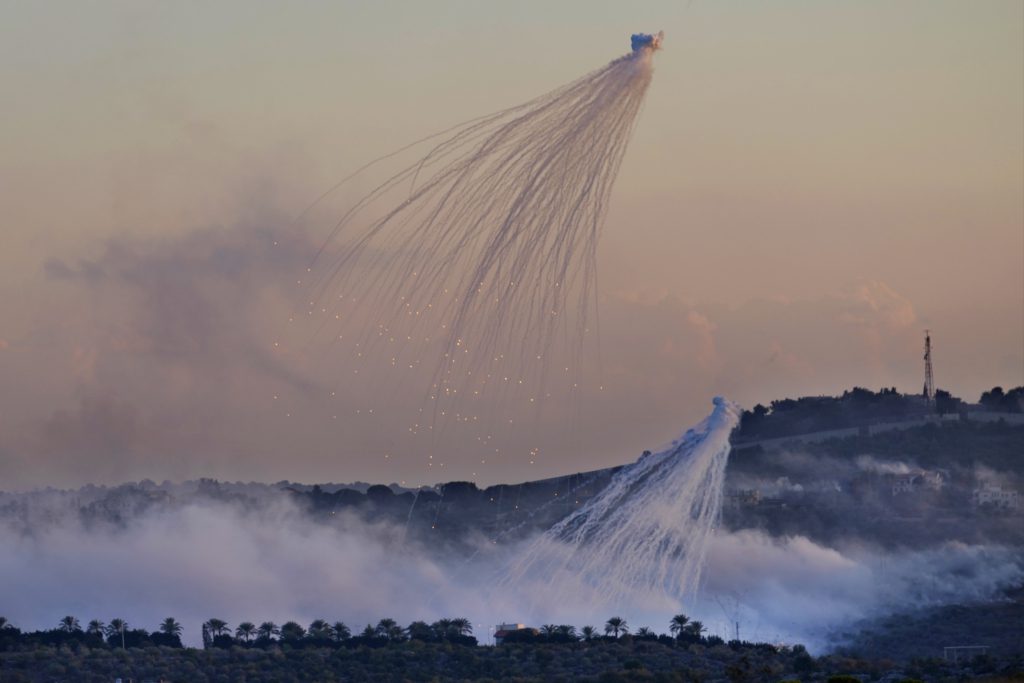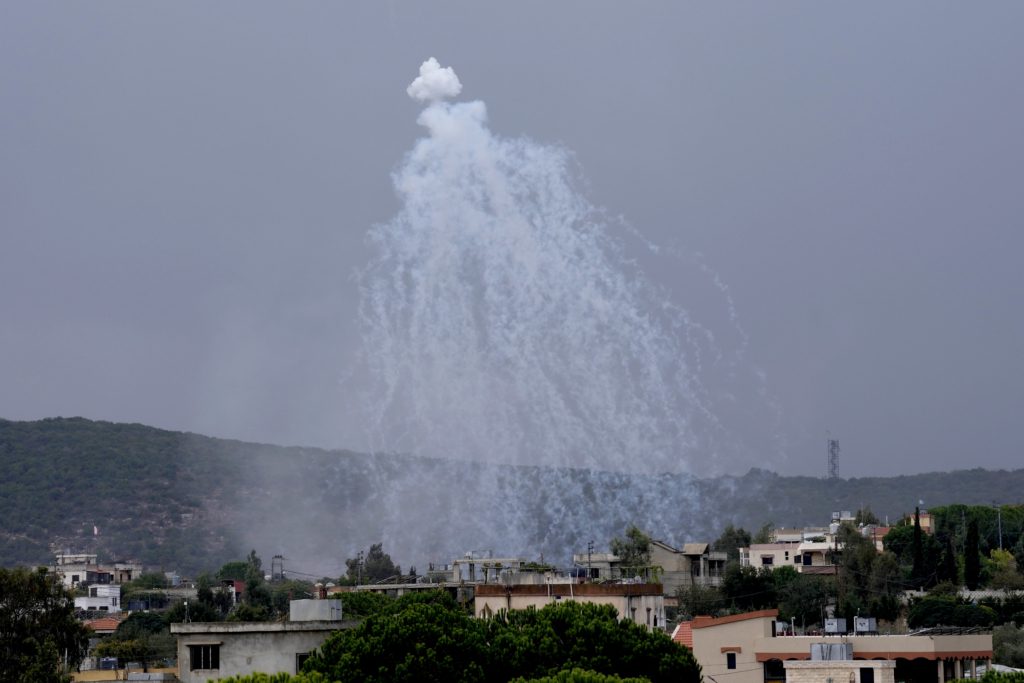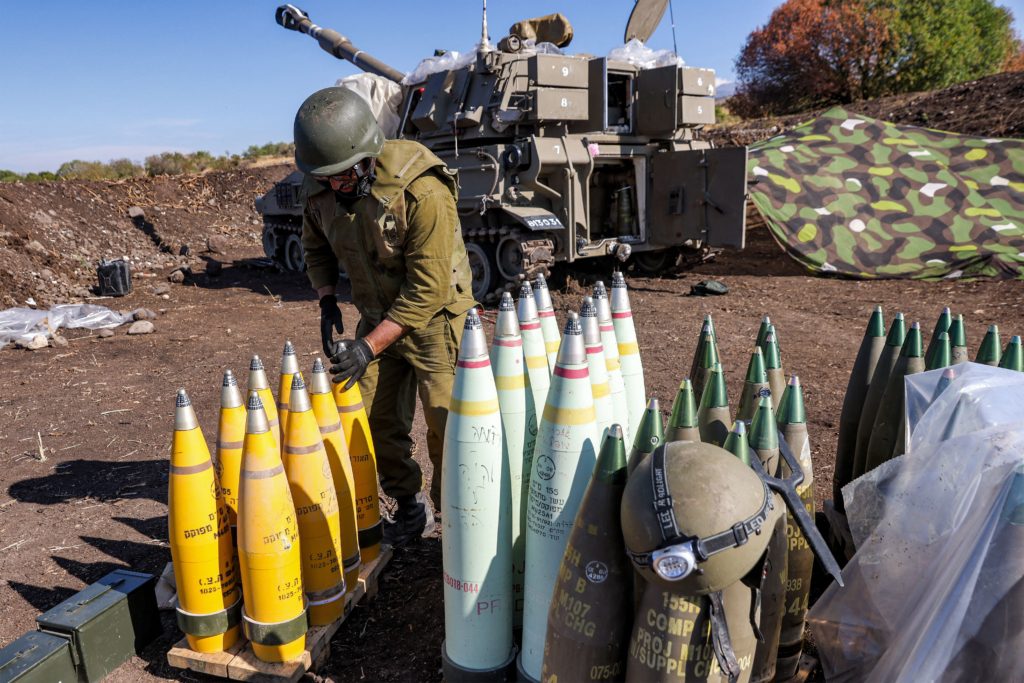The Israeli army fired artillery shells containing white phosphorus, an incendiary weapon, in military operations along Lebanon’s southern border between 10 and 16 October 2023, Amnesty International said today. One attack on the town of Dhayra on 16 October must be investigated as a war crime because it was an indiscriminate attack that injured at least nine civilians and damaged civilian objects, and was therefore unlawful, said the organization.
Cross-border hostilities in southern Lebanon have escalated significantly since 7 October. Israeli shelling in Lebanon has killed at least four civilians and 48 Hezbollah members so far. Hezbollah and other armed groups have also fired rockets at northern Israel, killing six Israeli soldiers and one Israeli civilian, according to the Israeli army. Amnesty International is investigating attacks by Hezbollah and other armed groups on northern Israel to determine whether they violated international humanitarian law.
“It is beyond horrific that the Israeli army has indiscriminately used white phosphorous in violation of international humanitarian law. The unlawful use of white phosphorus in Lebanon in the town of Dhayra on 16 October has seriously endangered the lives of civilians, many of whom were hospitalized and displaced, and whose homes and cars caught fire,” said Aya Majzoub, Deputy Regional Director for the Middle East and North Africa at Amnesty International.
“With concern growing about an intensification of the hostilities in southern Lebanon, the Israeli army must immediately halt the use of white phosphorus, especially in populated areas, in line with its forgotten 2013 pledge to stop using these weapons. It must abide by its commitment and stop further endangering the lives of civilians in Lebanon.”
The usage of white phosphorus is restricted under international humanitarian law. Although there can be lawful uses, it must never be fired at, or in close proximity to, a populated civilian area or civilian infrastructure, due to the high likelihood that the fires and smoke it causes spread. Such attacks, which fail to distinguish between civilians and civilian objects and fighters and military objectives, are indiscriminate and thus prohibited.
White phosphorus is an incendiary substance mostly used to create a dense smoke screen or mark targets. When exposed to air, it burns at extremely high temperatures and often starts fires in the areas in which it is deployed. People exposed to white phosphorus can suffer respiratory damage, organ failure and other horrific and life-changing injuries, including burns that are extremely difficult to treat and cannot be put out with water. Burns affecting only 10 percent of the body are often fatal.
It is beyond horrific that the Israeli army has indiscriminately used white phosphorous in violation of international humanitarian law.
Aya Majzoub, Amnesty International
The body of evidence reviewed by Amnesty International indicates that Israel has used white phosphorus smoke artillery shells during an attack on the southern border town of Dhayra, a populated civilian area. Amnesty International’s Crisis Evidence Lab verified videos and photos showing the use of white phosphorous smoke artillery shells in Dhayra on 16 October. Amnesty International researchers interviewed the Mayor of Dhayra, a resident of Dhayra, a first responder who facilitated the transfer of injured civilians to a nearby hospital and an emergency doctor working in the hospital which received the injured civilians.
The team also gathered compelling evidence indicating the use of white phosphorus in three other incidents between 10 and 16 October in Dhayra and the border towns al-Mari and Aita al-Chaab, by verifying videos and photos of these attacks.

Amnesty International’s Crisis Evidence Lab verified a video showing artillery-dispersed smoke plumes, consistent with white phosphorus munitions, on 16 October in Dhayra.

Doctor Haitham Nisr, an emergency doctor at the Lebanese Italian hospital, told Amnesty International that on 16 and 17 October, medical teams treated nine people from the towns of Dhayra, Yarine and Marwahin who were suffering from shortness of breath and coughing, which he said was due to inhaling white phosphorus. Most patients were discharged from the hospital on the same day, he said.
The Regional Director of the Lebanese Civil Defence, Ali Safieddine, who facilitated the transfer of injured civilians to the hospital on 16 October and the subsequent evacuation of the town on 17 October, told Amnesty International that the Civil Defence received calls for help from residents who reported “bombs that are producing extremely bad odour and causing suffocation once inhaled… Four members of our staff as well as a number of people living in Dhayra were admitted to a hospital for suffocation in the past few days.”
“We were not able to see even our own hands due to the heavy white smoke that covered the town all night long and lasted till this morning [17 October],” Ali Saffiedine told Amnesty International. This description is consistent with white phosphorus, which produces a dense white smoke and a garlic-like odour.
According to the Mayor of Dhayra, Abdullah al-Ghrayyeb, the shelling of the area, including with white phosphorus, started around 4:00pm local time on 16 October and continued into the night.
“A very bad odour and massive cloud covered the town so that we were not able to see beyond five or six metres in front of us. This caused people to frantically flee their homes. And when some returned two days later, their houses were still burning. Cars caught fire. Land areas were also burnt down. Until today, you find remnants – the size of a fist – that reignite when exposed to air,” Abdullah al-Ghrayyeb told Amnesty International.
Amnesty International’s Crisis Evidence Lab analysed a video showing a crusted-over white phosphorus felt wedge reigniting in a resident’s backyard when poked with a stone. According to al-Ghrayyeb, the resident took the video on 25 October, nine days after Dhayra was shelled with white phosphorus. White phosphorus can reignite when exposed to oxygen, even weeks after it is deployed.
Under international humanitarian law, all parties to a conflict must, at all times, distinguish between civilians and civilian objects, and fighters and military objectives and direct their attacks only at fighters and military objectives. Indiscriminate attacks – those that fail to differentiate between civilians and military objectives as required – are prohibited. Launching an indiscriminate attack resulting in loss of life or injuries to civilians or damage to civilian objects is a war crime.
White phosphorus should therefore never be used in areas populated by civilians, due to the high likelihood that the fires and smoke will spread, which would render such attacks indiscriminate. This attack on Dhayra, which injured civilians and damaged civilian objects, was indiscriminate and therefore unlawful. It must be investigated as a war crime.
Additionally, Amnesty International verified a video from Dhayra dated 13 October, showing artillery-dispersed smoke plumes, consistent with white phosphorus munitions. It also analysed footage filmed by a journalist on 10 October in Dhayra, seeming to show the release of white phosphorus igniting following contact with air.
Amnesty International’s Crisis Evidence Lab also verified footage showing the shelling of the border town of Aita al-Chaab and near the town of al-Mari in southern Lebanon.
Two videos verified by Amnesty International’s Crisis Evidence Lab filmed on 10 October around al-Mari show ignited felt wedges descending to the ground and instigating widespread fires, almost certainly indicating the use of white phosphorus.
Amnesty International also verified one video and five photos showing the shelling of Aita al-Chaab on 15 October, which very likely show the use of a mixture of white phosphorus rounds and standard high explosive artillery projectiles.

Amnesty International’s Crisis Evidence Lab verified photos taken by AFP photographers on 18 October near the Lebanese border. These photos show 155mm white phosphorus smoke ammunition shells lined up for use next to Israeli army M109 howitzers. These shells have a distinctive pale green colour and red and yellow colour bands, as well as visible markings reading M825A1 and D528, respectively the shell’s nomenclature and the US Department of Defense Identification Code (DODIC) for white phosphorus-based ammunition, as already documented by Amnesty International near the Gaza fence. While these are US codes and nomenclatures, Amnesty International cannot confirm where these shells have been manufactured.


International law
White phosphorus is not considered a chemical weapon because it operates primarily by heat and flame rather than toxicity, making it an incendiary weapon. Its use is governed by Protocol III of the Convention on Conventional Weapons (CCW). Lebanon acceded to the protocol in 2017, but Israel has not.
Protocol III prohibits the use of airdropped incendiary weapons in “concentrations of civilians,” and limits the lawful use of ground-launched incendiary weapons – such as the artillery documented here – where there are concentrations of civilians. The protocol defines incendiary weapons as ones “primarily designed” to set fires and burn people, excluding uses of incendiary weapons for other purposes, including as smokescreens.
Background
Cross-border hostilities have escalated since the attacks in southern Israel on 7 October, in which Hamas and other armed groups killed at least 1,400 people and took over 200 hostages, most of them civilians, according to Israeli authorities, Israeli forces have launched thousands of air and ground strikes on the Gaza Strip, killing more than 8,000 people, mostly civilians, including at least 2,704 children, according to the Palestinian Ministry of Health in Gaza. More than 17,439 have been injured and over 2,000 bodies are still trapped beneath the rubble while the health sector is on its knees.
In October, Amnesty International documented the use of white phosphorus artillery shells by the Israeli army in densely populated civilian areas in Gaza, some of which may be considered indiscriminate attacks and therefore unlawful. On 14 October, Israeli authorities denied that they used white phosphorus in their military operations in Gaza and Lebanon.
According to the International Organisation for Migration, as of 27 October, almost 20,000 residents in southern Lebanon have been displaced due to the hostilities. Israeli authorities also announced that they were evacuating 28 towns in northern Israel along the border with Lebanon, comprising around 60,000 residents.
Tags: Israel, Human Rights, Liberty of expression, Gaza.
Kyrgyzstan: Detention of Rita Karasartova is sign of deepening repression
Azerbaijan: Authorities must immediately release Tofig Yagublu
Israel: Long overdue release of Ahmad Manasra marks a path to recovery
Honduras: The candidates have an opportunity to commit to human rights
El Salvador: Fidel Zavala, human rights defender, at risk of torture
Contact Us
Regional - Américas
Calle Luz Saviñón 519, Colonia del Valle Benito Juárez, 03100. Ciudad de México, México
Global
1 Easton Street, London WC1X 0DW. Reino Unido.